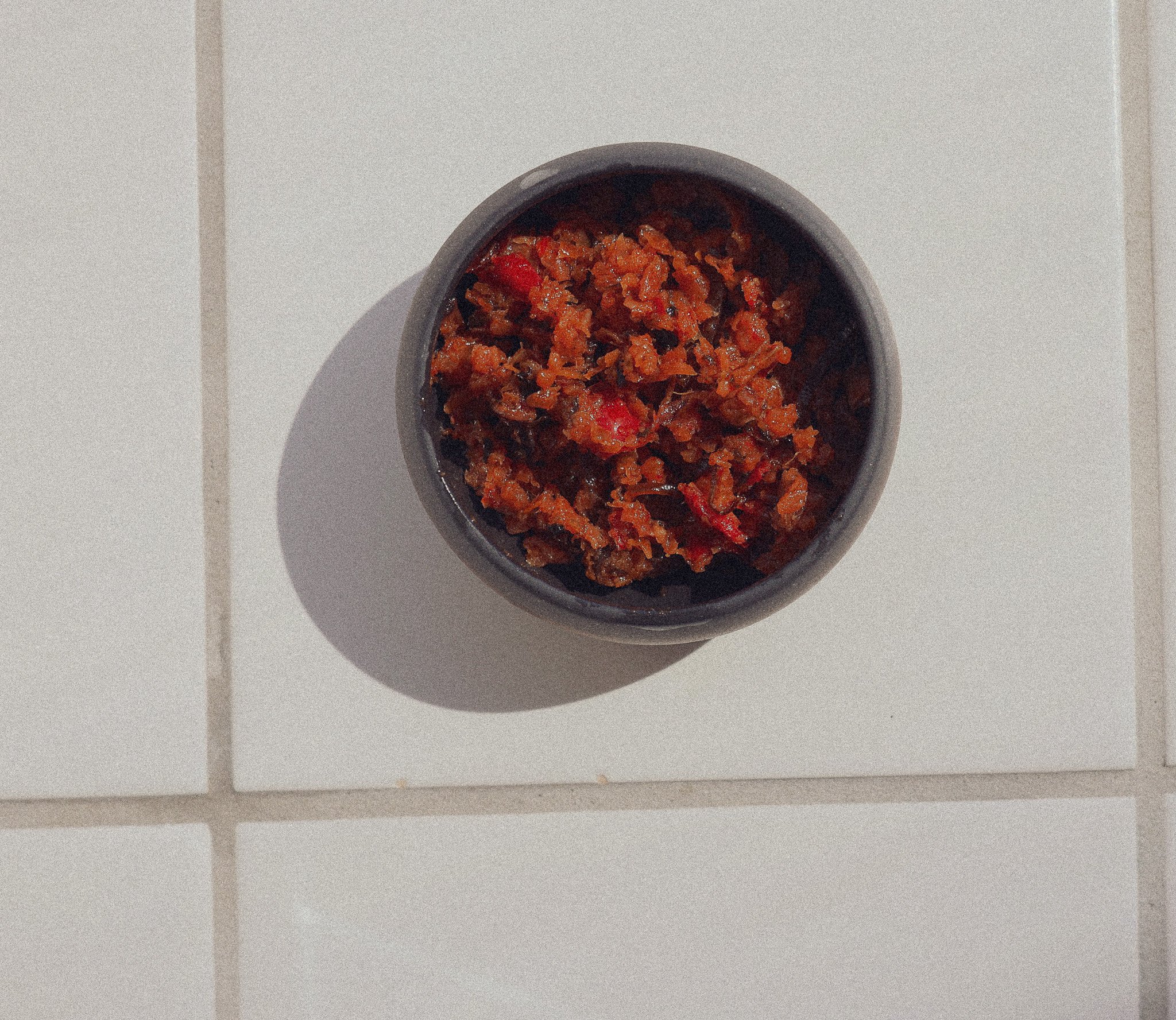Cauliflower XO-ish
This is part of our series on upcycling farm by-products and fruit & veg by-products.
Table of Contents
i. Background
Many people tend to only eat the florets of cauliflowers. Chefs and home cooks alike often waste perfectly edible leaves and stems. Furthermore, during harvest, most of the plant's outer leaves are discarded, and the stems are typically left to rot in the field along with heads that don’t meet strict cosmetic standards and aren’t considered economically viable to harvest. Much the same can be said for other popular brassica crops like broccoli, kale, and Brussels sprouts.
This recipe offers one way cauliflower by-products can be used, with delicious results. We lacto-ferment them, making use of the plant’s naturally occurring microbiota, before smoking and drying them and using them to make a smokey, salty, umami-rich condiment. This condiment is based on XO sauce from Hong Kong, which is full of umami and texture, and usually made of seafood and pork. This version could be used in much the same way, though just happens to be vegan.
At first glance, the XO-ish sauce recipe might not appear to use that much cauliflower. However once fermented and dehydrated, every 1kg of cauliflower trimmings produces about 100g of concentrated, flavour-packed cauliflower pieces that can be used as an ingredient in recipes like the XO-ish sauce.
ii. Recipe
a. Fermented cauliflower
Ingredients
Cauliflower trimmings e.g. leaves and stems, cleaned
2% salt, by weight of the cauliflower trimmings
Method
Put the cauliflower trimmings through a meat grinder, or mince by hand.
Mix with the salt, anaerobically seal (e.g. vacuum seal) and leave the mixture to ferment for 1 week at room temperature.
Remove the cauliflower from the fermentation vessel/vacuum bag and dry it in a dehydrator. During drying, smoke the cauliflower heavily at least three times, or dry it in a smoker if possible. This results in a shelf-stable product that can be made in bulk and stored for later use. If you cannot smoke the cauliflower you could instead use smoked chillis or add a very controlled amount of liquid smoke to the recipe.
b. Cauliflower XO-ish sauce
Method
Heat the oil to 180°C and fry the fermented cauliflower until it just starts to colour. Set aside, keeping the oil in the pan.
Fry the dried mushrooms in the oil until they start to colour. Set aside, keeping the oil in the pan. Once they cool and harden, roughly grind the mushrooms using either a spice grinder or a pestle and mortar.
Fry the 200g sliced garlic until golden. Set aside, keeping the oil in the pan.
Fry the shallots until golden. Set aside, keeping the oil in the pan.
Fry the chilli. Set aside, and remove the cooking oil from the pan, reserving it for later. When the chilli is cool, crumble it with fingers or pestle and mortar.
Sweat off the onions and the remaining chopped garlic in a little of the reserved frying oil, until soft.
Add the red peppers and cook until the peppers lose their water and start to break down.
Add all the fried ingredients and kombu back to the pan and add the salt and sugar. Cook out for a further 5 minutes. Add a little more reserved used frying oil to moisten the mixture to consistency, if needed.
Put the mixture into sterile jars while hot and top with more of the reserved frying oil. Seal. Any remaining reserved oil can be saved and used for other dishes, as it is very flavoursome.
Ingredients
75g dried & smoked fermented cauliflower leaves and stalks (recipe A)
75g dried mushrooms
212g garlic, peeled, 200g sliced, 12g finely chopped
800g shallots, peeled and sliced
10g dried chilli, chopped
300g neutral oil
100g onion, chopped
40g kombu, hydrated and shredded
450g red peppers, chopped
5g salt
5g sugar
iii. Adaptations
This recipe is a bit of a faff to make for the trimmings of a single cauliflower, and is better suited to situations where you have sufficient quantities of cauliflower trimmings produced at once, whether that is at a restaurant or farm producing these trimmings in bulk, or a home cook prepping lots of cauliflower at once. We wouldn’t recommend freezing cauliflower trimmings to store them in bulk before fermenting, as this will kill the vegetable’s natural microbiota and it won’t ferment properly, and it will break down the texture making it soggy.
You could also use the base fermented cauliflower ingredient in other recipes, like sauces and relishes. It might be possible to adapt the recipe to use the trimmings of other brassica crops like kale stems—we haven’t yet quite nailed these variations ourselves, though we’d encourage you to experiment.
If you make this recipe or adapt it, let us know how it goes!
Contributions & acknowledgements
Kim performed the original culinary R&D. Eliot wrote the article in discussion with Kim. Josh contributed editorial feedback. Eliot photographed the cauliflower trimmings and Aly photographed the final product in our food lab.
This recipe has roots in Kim’s previous work as Head of R&D at the former Amass Restaurant in Copenhagen. Thanks to Amass for facilitating such trailblazing work in culinary upcycling and holistic sustainability.





